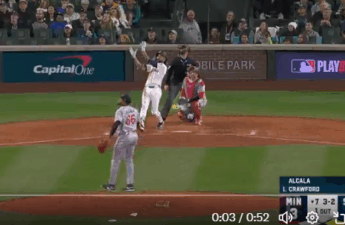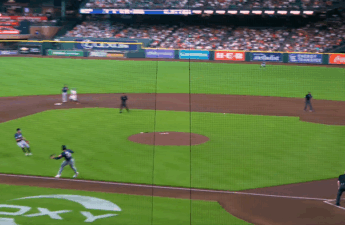While my overall interaction with 2017 NPDA Nationals was overwhelmingly wonderful, some of the joy was marred at times by confusion over a very strange tab policy that was included in this tournament. The tab policy was to protect schools against hitting their own teams in elimination rounds, breaking the bracket to do so.
Here’s the official wording of the policy:
In the event that two teams from the same school meet in elimination rounds, brackets will be broken according to the following criteria: (1) protecting the highest seed; (2) changing the fewest number of brackets; (3) preserving original bracket order.
Now in most debate tournaments, it’s normal to try to prevent teams from the same school from competing against each other (“hitting” each other) in preliminary rounds. APDA makes an exception if a team is the majority of a given bracket, but APDA also has a much larger appetite for school/school “civil wars” than NPDA. In NPDA, these rounds are never actually held, but one team (almost always the higher seed at the tournament) is simply chosen by the coach to “walk over” the other team. And while I can sort of understand a distaste for a coach’s decision walk-over ending someone’s career or Nationals run, school/school protection to upend the bracket seems to be a really extreme reaction to that distaste. And the effect is very imbalancing, strongly favoring schools who bring and break a lot of teams.
But when one subjects this year’s NPDA Nationals tournament’s application of their own policy to rigorous analysis, it doesn’t necessarily even hold up as consistently applied, which is even more problematic. This post will examine the bracket-breaking switches made by the NPDA Nationals 2017 tab staff and their subsequent impact on the tournament and competitive fairness for all teams participating. And while the goal is to be objective and submit this with few comments, I must say that the data leads to the conclusion that this policy is sub-optimal for future such National Championships.
Let’s first examine the base bracket:
Partial Triple-Octofinals
It’s probably worth noting at the top how many schools broke teams to the elimination rounds as context for this policy and its impact:
Washburn: 6
Concordia: 4
Utah: 4
Lewis & Clark: 3
Point Loma: 3
Rice: 3
Texas Tech: 3
Berkeley: 2
Idaho: 2
Kansas City Kansas: 2
Mercer: 2
Pacific: 2
UT Tyler: 2
Western Washington: 2
12 other schools: 1 each
So fully forty of the fifty-two teams involved had teammates in the break! This demonstrates that the scale of magnitude for this question is not small. And with six teams in the break, including the 1 and the 4 seeds, it is unsurprising that Washburn will be a major player as the drama of bracket-breaking unfolds.
Now as we look at our partial-triple-octos bracket, we find that the two Mercer teams have been paired to hit each other, which would be pretty bad luck were they allowed to actually hit. But under this policy, the following swap is made:
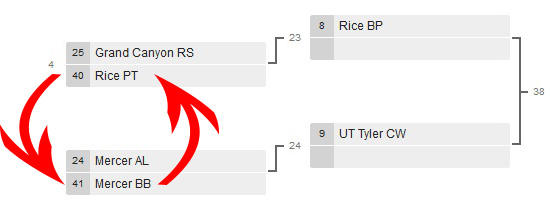
This seems pretty reasonable on face – the teams are in neighboring brackets and the 40 is switched with the 41. Interestingly, however, it violates the stated first priority in the protection policy, namely to protect the higher seed. In this switch, the higher seed (#24 Mercer AL) now gets a moderately higher draw, #40 Rice PT, instead of the #41 seed. Granted, this is a very minor difference in opposition quality, but it still punished the higher seed. Worth noting, at this point, that to not punish the higher seed, you would have had to swap the #42 seed with the #41, but then that punishes the new higher seed involved (#23 Lewis & Clark MM), so this problem cannot actually be solved without kicking the can down the road all the way to the top of the bracket. Which basically shows that the “protect the higher seed” priority, despite being first, makes no sense.
So, partial-trips happen and, as luck would have it, both Mercer teams drop. Turns out they’d have been better off with the walk-over after all, but good news for Grand Canyon RS and Rice PT, one of whom really should be out of the tournament. On to double-octos:
Again, we have one problem to resolve in the school/school protection question, where Pacific’s two teams are set to hit in round 22. And there would be a danger of a Rice/Rice round just below in round 23, but this has been conveniently resolved by the previous swap of a Rice team in to upset Mercer. So, here’s the switch still necessary:
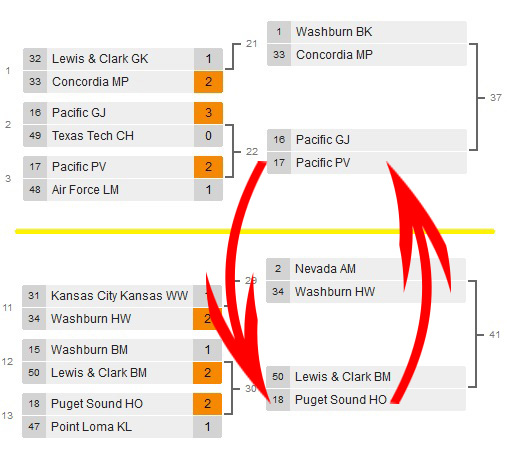
This looks dramatic, because it switches the teams all the way across the brackets, but the 15/18 match is the natural cousin of the 16/17 match. Here, the higher seed is actually protected, because they now get the 18 seed instead of the 17, but that’s only because the actual team entitled to the higher seed is #50 Lewis & Clark BM, the lowest seed left in the tournament. They inherit the #15 seed slot, so they should probably get protected, but no matter.
Of course, you know what’s going to happen, right? We can’t just have things resolve cleanly. Both Pacific teams pick up their rounds (tough luck to the #50 seed and to Puget Sound’s lone team who should’ve hit them). And, for extra fun, both Rice teams that couldn’t hit also pick up their rounds, slotting them to hit one round later than they would’ve anyway (bad news for UT Tyler and Grand Canyon, one of who should be through instead). At this point, Challonge won’t even let us express the bracket as it’s been altered because of too many swaps, so we have to start over in doubles with manual seeds listed.
Thus, here’s how things stand going into octos:
Octofinals
The problems are multiplying. The Rice teams that should have hit last round again are hitting this round. And now we have a double Washburn match to take care of as well. Teams are going to be sent flying to other bracket halves again. And it’s worth nothing that #17 Pacific PV, the second overall team in the season-long rankings, is now stationed in place of the 15 seed, staying on the other half of the bracket from where they should have traversed the tournament. This will have major consequences for #2 Nevada AM, as we’ll see in a bit.
So here are your swaps for this round:
First, the Washburn/Washburn round:
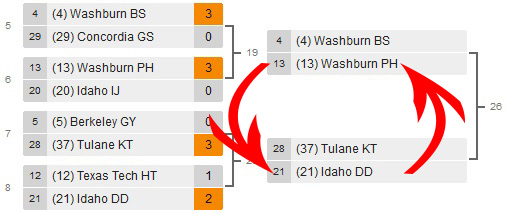
This is where we became aware of the switching. We even called tab to ask because we thought we were supposed to hit Idaho and they said “there’s no bracket that we’ve released, so you shouldn’t expect to hit anyone”. They could have just explained that there were school-switching swaps here, as stated in the packet, but they chose to be cagey. It’s worth noting here that, while this is the technically least invasive switch, both Tulane and Idaho can have a legitimate concern with this swap. They are both supposed to hit teams lower in the seeding order. In fact, Idaho has gone from hitting a 37 seed to a 4 seed just to protect Washburn. By comparison, our swap from a 21 seed to a 13 seed looks relatively fair. But this still concretely hurt both team’s competitive chances, favoring Washburn significantly by both sparing them the harder match-ups and preventing them from eliminating each other.
Meanwhile, here’s the Rice/Rice resolution:
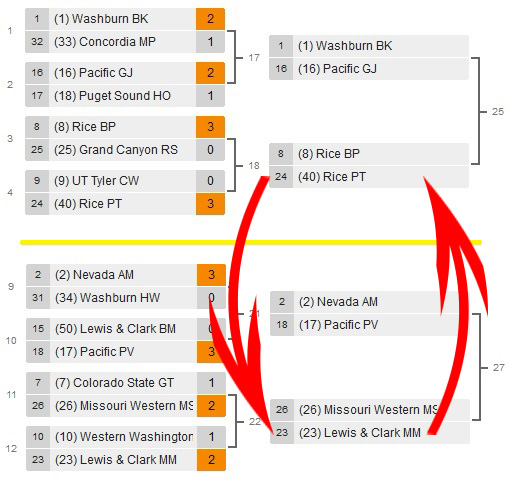
Again, some upset teams from get penalized for their wins here. Not systemically, mind you, but by happenstance that nonetheless risks impacting their tournaments significantly. Rather than the 23 and 26 seeds enjoying their 7/10 octofinal as a reward for upsetting those teams, the 23 is shipped off to face the #8 seed, while the #40 gets the #26 instead of the #8. This is ostensibly a reward for both the #40 and the #26 to get each other, but also ships the #40 to a whole new half of the bracket where, like #17 Pacific PV above, they never would have been but for all these switches.
Here, the Cinderella teams maintained their runs, as #37 Tulane upset the #13 seed, and both the #40 and #23 triumphed over their higher seeded opponents. But this also offers us a rare situation where exactly one of the protected school teams in each instance won their rounds, meaning that restoration of the bracket should be possible in the quarterfinals. For the Tulane/Washburn quarter, this is irrelevant, but for the Rice and Lewis & Clark teams, this mattered very much indeed.
So, let’s see where things stand going into quarterfinals:

Here is where the most obviously problematic decision was made in the whole tournament. The tab staff chose to leave this bracket alone. But the problem is that #23 Lewis & Clark MM belongs in quarterfinal match 11 as listed in the above link, being in the bottom half of the bracket. And #40 Rice PT belongs in up in match 9 on the top half. They both just swapped with each other to avoid a Rice/Rice round. So why were they not restored to their original brackets? Surely that is preserving original bracket order as stated in the policy. And it doesn’t create a school/school conflict, because Washburn can safely hit Rice while Pacific hits Lewis & Clark.
Of course, it’s worth noting that Pacific PV also belongs in the top quarterfinal there: because of all the bracket-breaking, three teams from the same quarter of the bracket are now in quarterfinals. Here, let’s flash back to the opening of the tournament when all the seeds were in order:
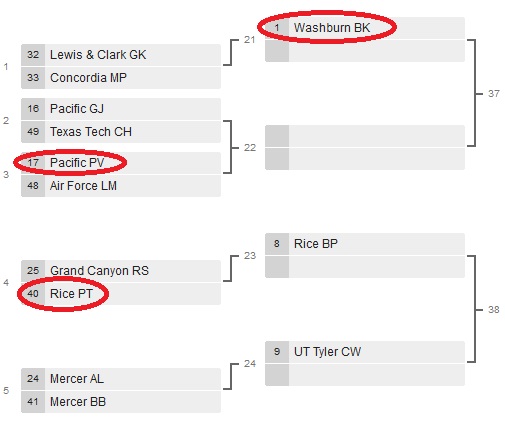
So really, all three of those teams should be squeezed into that one match-up. But that’s not clean and that’s not really doable at this point, so leave Pacific PV where they are. Restoring the bracket is clearly the least disruptive action here as it regards Rice and Lewis & Clark, since their bracket switch just happened the previous round and puts each of them in their rightful position without creating additional conflicts.
Nevertheless, they left the altered bracket as-is and ran these quarterfinals. The lower seeds were both bounced, though Lewis & Clark nearly upended the top seed, so we can surmise they might have had a better chance against Pacific. And the top seed should have been “protected” by getting the easier and rightful draw of #40 Rice.
So here’s where we were going into Semifinals:

And here, as you can imagine, what proved to be the last two rounds of the tournament were, again, switched to protect Washburn. #6 Berkeley traveled up to hit #1 Washburn BK instead of the #17 seed and #4 Washburn BS came down to hit the #17 instead of the #1. Both Washburn teams triumphed, yielding the first closeout in NPDA Nationals history and cancelling the final round.
Once again, the competitive disadvantage for Berkeley and Pacific is clear. Each should have had an easier path to the finals. Meanwhile, both Washburn pairs were rewarded for having their teammates still in the tournament, receiving a much easier draw.
I want to be clear about what I’m not saying. I am not saying that anyone involved with NPDA Nationals deliberately took any actions to favor Washburn, or any particular school. However, it is clear that this policy directly contributed to Washburn being able to closeout, as well as favoring Washburn teams generally. Washburn can attribute much of their top two teams’ ultimate outcome to getting 6 teams into the break in the first place, maximizing bracket-breaking that ultimately worked in their favor.
The main counter-arguments that could be levied to my concerns are, as I see them, twofold:
(1) Schools should be rewarded for breaking more teams.
(2) Teams still failed to win the rounds they were in to advance and should not blame the bracket.
As for (1), I think it’s a little silly. For one thing, the standard bracket does reward them, slightly, by guaranteeing in the instances where a school would hit the same school that one of those teams definitely advances. It’s an advantage – ask Mercer if you don’t believe me. But there’s still a difference between a reward and being able to negatively impact the fates of several other teams in the wake of getting you to avoid hitting your own school. I know it’s sad to leave your last tournament on a walk-over, but it’s also sad to hit a much better team than you deserved to. When both of these are sad outcomes, it seems like honoring the original bracket is best, especially when not doing so leads to subjective judgment calls like failing to restore the bracket for quarterfinals.
I find (2) to be a little more compelling, but ultimately a red herring. Obviously we care very much about honoring seeding and the bracket in general at tournaments. We don’t break brackets at other tournaments, for one thing. But we also spend eight (8) full preliminary rounds determining how the seeding should be allocated. Teams have worked hard to earn their seeding and their position. And teams that have won big upsets deserve to get rewarded for those upsets. If they didn’t, we would re-seed the bracket every time and #40 Rice PT would have had a date with #1 Washburn BK back in octos (presuming they’d gotten by #2 Nevada AM in doubles). We don’t force Cinderellas to do this, any more than the NCAA basketball tournament forces you to hit a one seed after beating a one seed. So the instances above where upset teams were supposed to hit each other and were instead switched to hit higher rated teams – it seems these squads have a legitimate complaint.
The past is the past. We’re not going to re-run NPDA Nationals. Some of the teams were little impacted, but many arguably would have gone further or less far based on this bracket decision. Ultimately, all the rounds were won and lost and judged fairly as they were announced. But in future years, it seems obvious that the NPDA should at the very least clarify what these alleged tab priorities mean when breaking brackets (addressing, for example, bracket restoration and what exactly “protecting the highest seed” really means). And most likely, they should just scrap this school/school protection scheme altogether and let the seeds fall where they may.

